Sacred Signs : 2
Sacred Signs : 2
The pronunciation of Ancient Egyptian has been attempted by using languages such as Coptic as a guide. A universal method of pronunciation has not been adopted and Egyptologists tend to aim for clarity rather than authenticity when they are discussing words and language. It may be that speakers of arabic have an advantage in reading out Egyptian transliteration aloud, and perhaps an Egyptian arabic accent lends itself best to some of the ancient sounds.
Attempts in the cinema to represent ancient Egyptian have not been always successful, but the modern ‘Mummy’ series of films at least give an impression of the spoken language.
Transliteration
2.1 The text reproduced here has been written in a computer-generated hieroglyphic font, having been transcribed from a document originally written on papyrus. The words are then transliterated in order to help the reader of the text to understand some of the grammatical forms and how the words have been divided. The transliteration stage is the best method by which the reader of a text can communicate to others the exact way in which they interpret the text from a grammatical and vocabulary based point of view. It can make the difference in translation to verb tenses, verb forms and word order.


Past tense verb form, with ‘he’ as subject (yellow) ‘Then he brought back’
Object of the action (purple) ‘the waters of the lake’
Adverbial description formed by putting a preposition in front of a noun (green) ‘to their places’.
‘Then he brought back the waters of the lake to their (original) places’
Determinatives
2.2 This is part of a text written in hieroglyphs in the Tomb of Ineni at Thebes. The determinatives in the text have ben highlighted in red. They do break up the text into blocks, where there is no other means of punctuation, but there is no consistent rule about how and when they should be used.
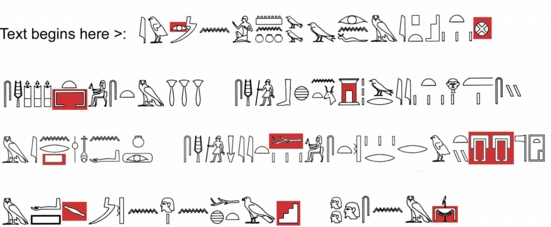
Old Kingdom Monumental Texts
2.3 This is a false-door text from Saqqara, dating to the reign of Unas or afterwards in Dynasty 5.
It is a typical example of its kind.

1. Reads from right to left in horizontal lines: this is the funerary offering formula.
A gift which the king gives (and) a gift which Anubis foremost of the shrine gives: his burial in his tomb for the one provided for before the great god, the sole companion, the overseer of the Khenty-she, Khen-nu’.
To the left there is a small image of Khen-nu with his name written above his head.
2. The main scene shows Khen-nu at his offering table eating.
3. The funerary offering text is repeated on the left hand side: A gift which the king gives (and) a gift which Anubis foremost of the shrine, one-upon-his mountain of the west, Lord of the Sacred Land gives: a spoken offering of bread and beer comes for the one who is provided for Khen-nu’.
4. A string of titles: The Overseer of wep-she for the khenty-she (endowed lands and people) of the Beautiful Places of Unas, one who is provided for before Osiris, Lord of Busiris, noble of the king, courtier of the House, Khen-nu.
5. (Overseer) of the Khenty-she of the Beautiful Places of Unas, Khen-nu.
6. Four further columns of titles and wishes:
One who is provided for before the Great god, who makes festive the west before the foremost of ….. one who is provided for Khen-nu
The second line is not so clear, but mentions a title of priest of Horus Behdet in the Beautiful Places of Unas of Khen-nu.
To make live the Sole One, Lector Priest, Master of secrets of the House of the Morning, one who is provided for Khen-nu [*in this line the hieroglyphs are close together at the beginning, but become more spread out as the writer runs out of things to write].
A gift which the king gives and Anubis gives, a spoken offering of bread and beer comes, may his tomb be hidden in the cemetery of Horus of the desert, Khen-nu.
A Middle Kingdom Formula Stela
2.4 This text is from a stela in Liverpool Museum and it contains a standard Middle Kingdom funerary text.
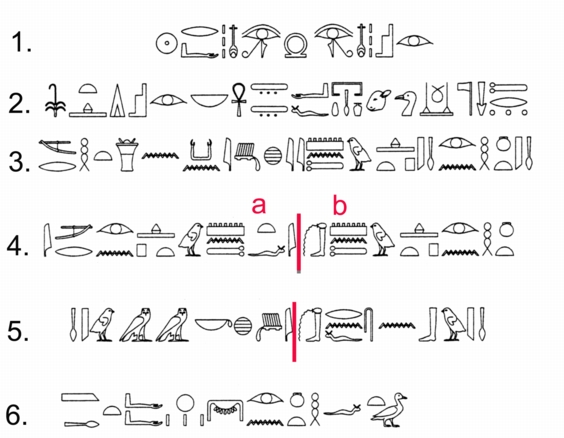
1. At the top of the stela are some protective mottoes:
the protection for the beauties of the eye of Osiris and Re
2. An offering which the king gives (and) Osiris Lord of Ankh-Tawy (the cemetery in Memphis). May he give a spoken offering of bread and beer, oxen and fowl, cloth and alabaster (containing ointment), incense
3. and unguent for the ka of the one provided for Montju-hotep , true of voice, born of Henut, true of voice.
4. [this line of text accompanies figures who are depicted on the stela underneath the appropriate label]
a. His father Montju-hotep, born of Mery
b. the waab-priest Montju-hotep, born of Henut
5. [the identity of these two people is not clear, but they may be relatives of Montju-hotep and they seem to be dead as they are called ‘true of voice’]
a. One provided for Kemmu, true of voice
b. the waab-priest, Renef-seneb, true of voice.
6. His daughter Henut, born of Nub-aat, true of voice.
The text shows how important family ties were in identifying people. The link with the mother is especially obvious and so is given prominence over mentioning the father of people.
2.5 We can construct a small genealogy based upon this stela, but cannot place Kemmu and Renef-seneb. It also seems that Montjuhotep’s eldest daughter is named after his mother, suggesting the importance of ancestral links.
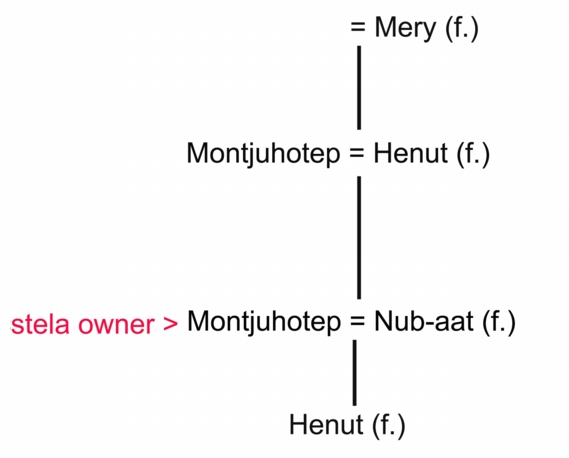
Examples of other scripts
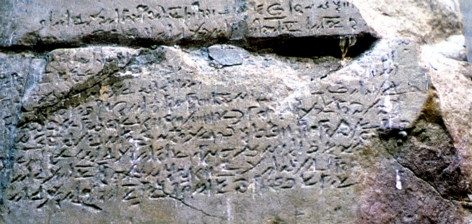

2.6 and 2.7
These are examples of demotic texts inscribed on the temple walls of Dakke temple in Nubia
One text is carefully carved and deeply engraved, perhaps a more official text. The other two texts are more lightly incised and may have been written by visiting priests.

2.8 This is a Coptic prayer painted in red ink inside Abydos temple.
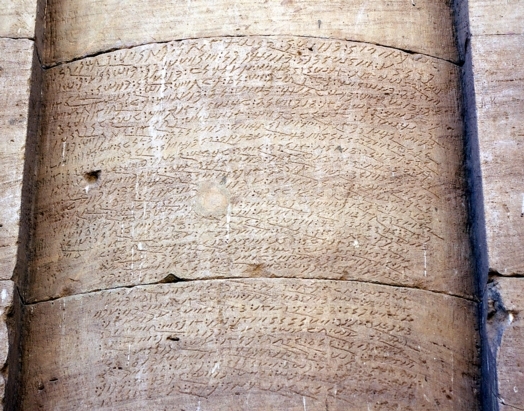
2.9 This is a Meroitic inscription carved on the front of the temple of Kalabsha, inside the first court.
